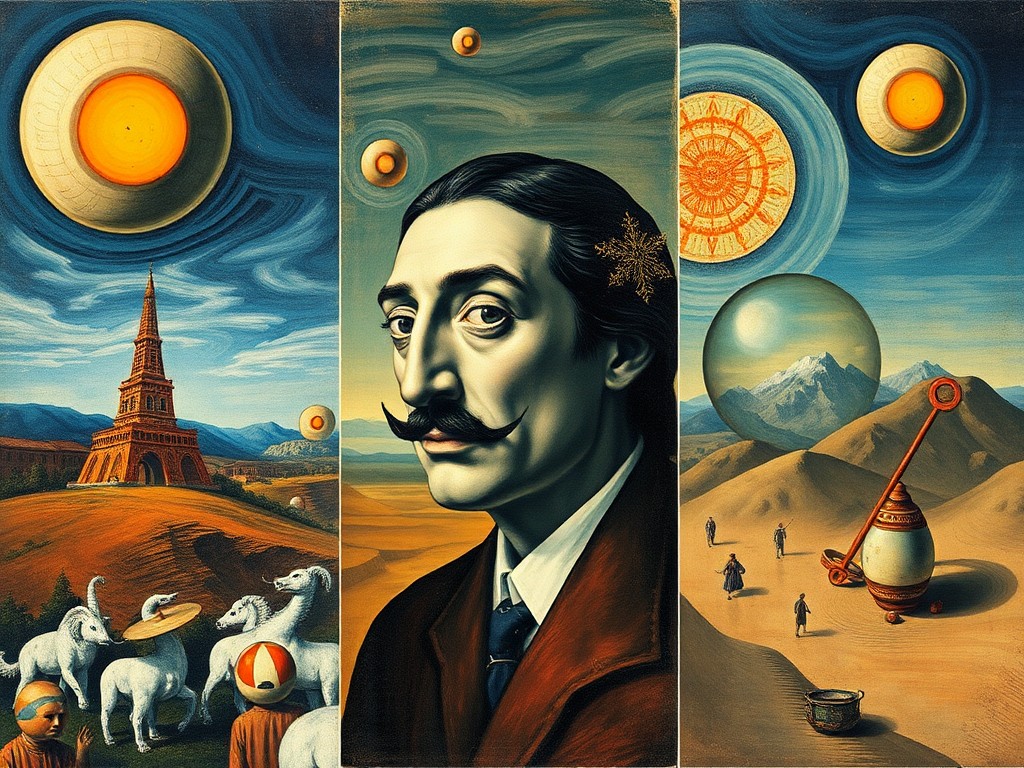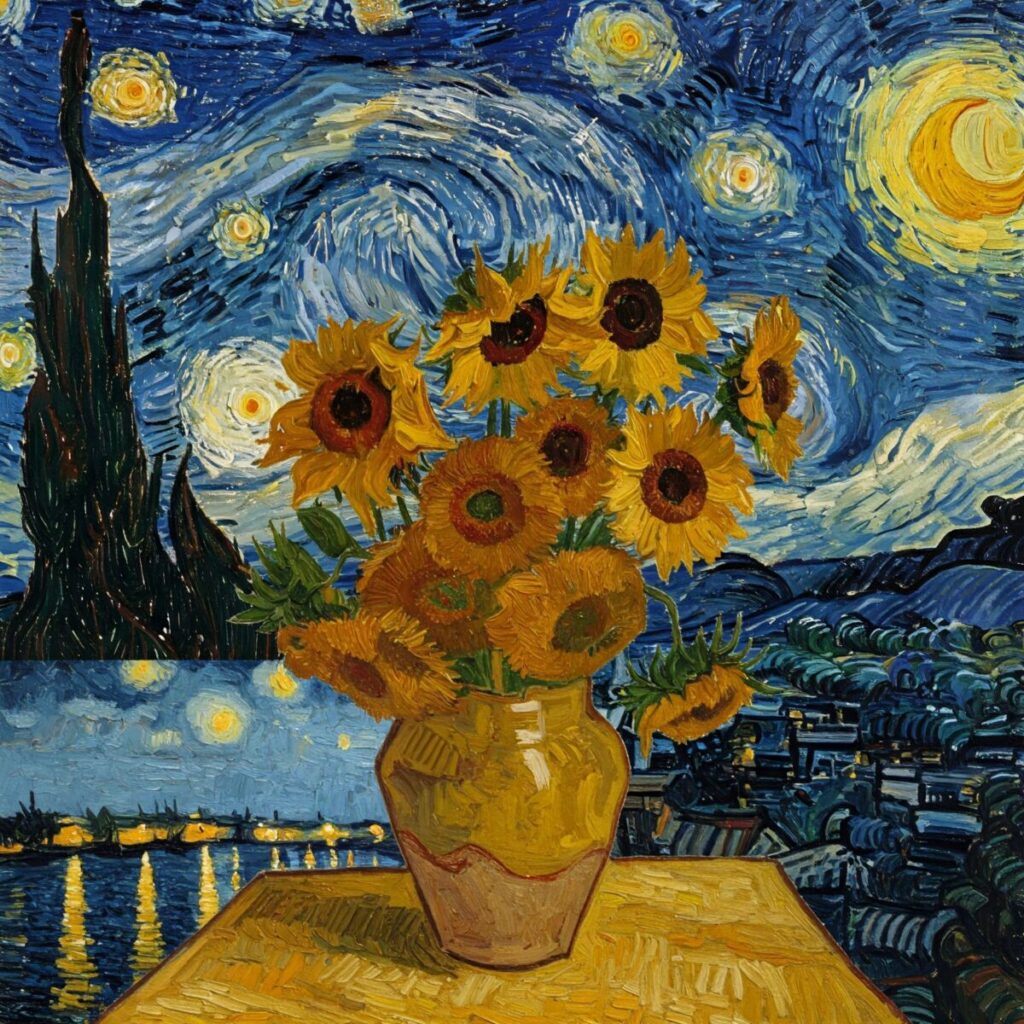Get ready to dive into a world bursting with color and emotion! Henri Matisse was a French artist who wasn’t afraid to break the rules. Imagine a painter who used color not just to show what something looked like, but how it felt. That was Matisse. He was a leader of a wild art movement called Fauvism, which means ‘wild beasts’ in French, because they used such intense, non-realistic colors. The collection of Matisse paintings is a vibrant journey through a revolutionary period in art history. He taught the world that a sky could be yellow, a face could have a green stripe, and a room could be completely, overwhelmingly red. Let’s explore the top 10 Matisse paintings that showcase his genius.
Dance (La Danse) (1910)
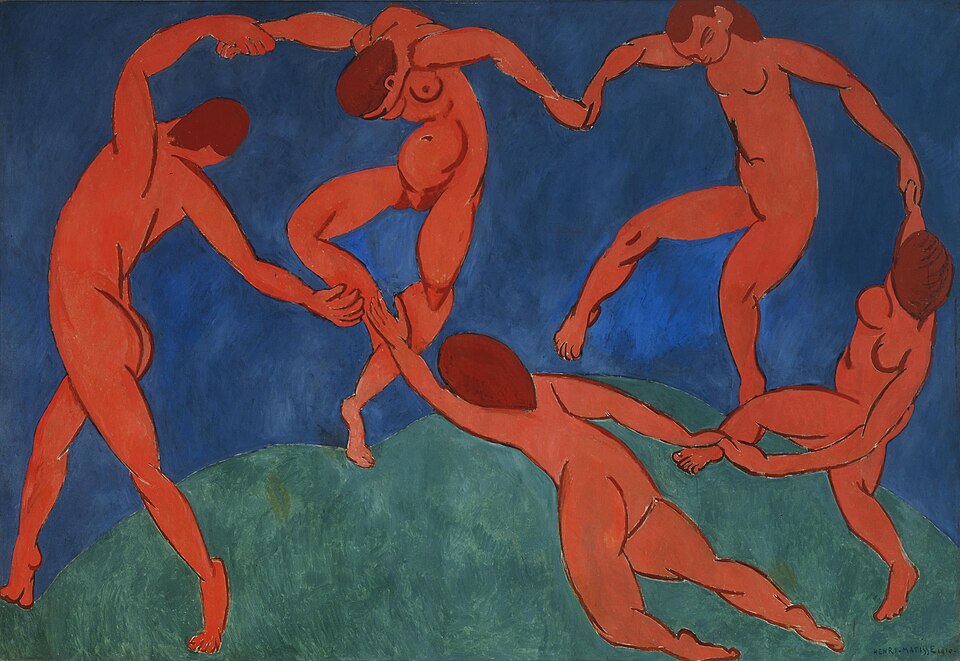
Description: Imagine five people holding hands, dancing in a circle with so much energy they seem to leap off the canvas. That’s ‘Dance’. Matisse used only three simple colors: a fiery red-orange for the figures, a deep blue for the sky, and a vibrant green for the ground. The painting is pure energy and joy, capturing the rhythm of life itself. It’s like the artist bottled the feeling of a perfect, carefree day and splashed it onto a huge canvas. This monumental painting was commissioned by a Russian merchant named Sergei Shchukin to decorate the staircase of his mansion in Moscow.
Painting Techniques: This is a prime example of Fauvism. Matisse used flat planes of bold, unmixed color and strong, simple outlines to create an emotional impact rather than a realistic scene. The composition is dynamic and primitive, focusing on rhythm and movement.
Location: The Hermitage Museum, St. Petersburg, Russia
Estimated Value: Priceless
The Red Studio (L’Atelier Rouge) (1911)
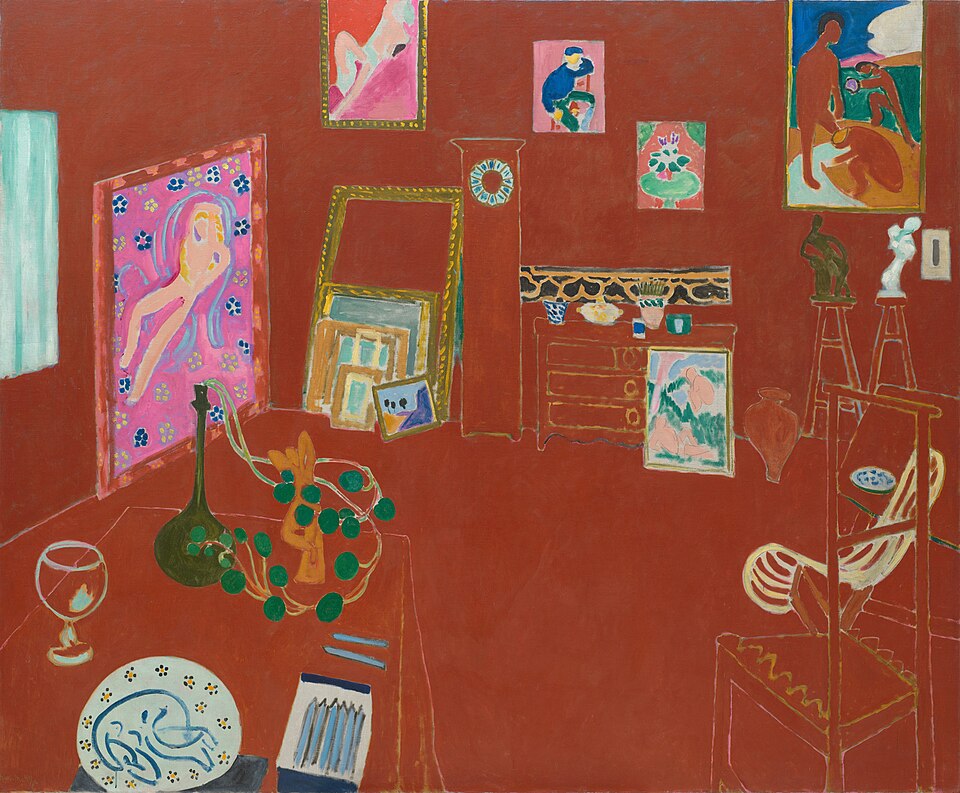
Description: Step inside Matisse’s own workspace! In ‘The Red Studio,’ the artist painted his studio, but with a twist: everything—the walls, the floor, the furniture—is washed in the same shade of deep red. His own paintings and sculptures are dotted around the room, outlined in white, like ghosts of his past creations. It’s a painting about painting, giving us a peek into the artist’s creative mind. Initially, the painting was not well-received and remained unsold for 16 years until it was purchased by a nightclub founder.
Painting Techniques: Matisse flattened the perspective, making the room feel both deep and two-dimensional at the same time. He used a single, dominant color (Venetian red) to unify the space and objects within it, a radical idea at the time.
Location: Museum of Modern Art (MoMA), New York City, USA
Estimated Value: Priceless
Woman with a Hat (Femme au chapeau) (1905)
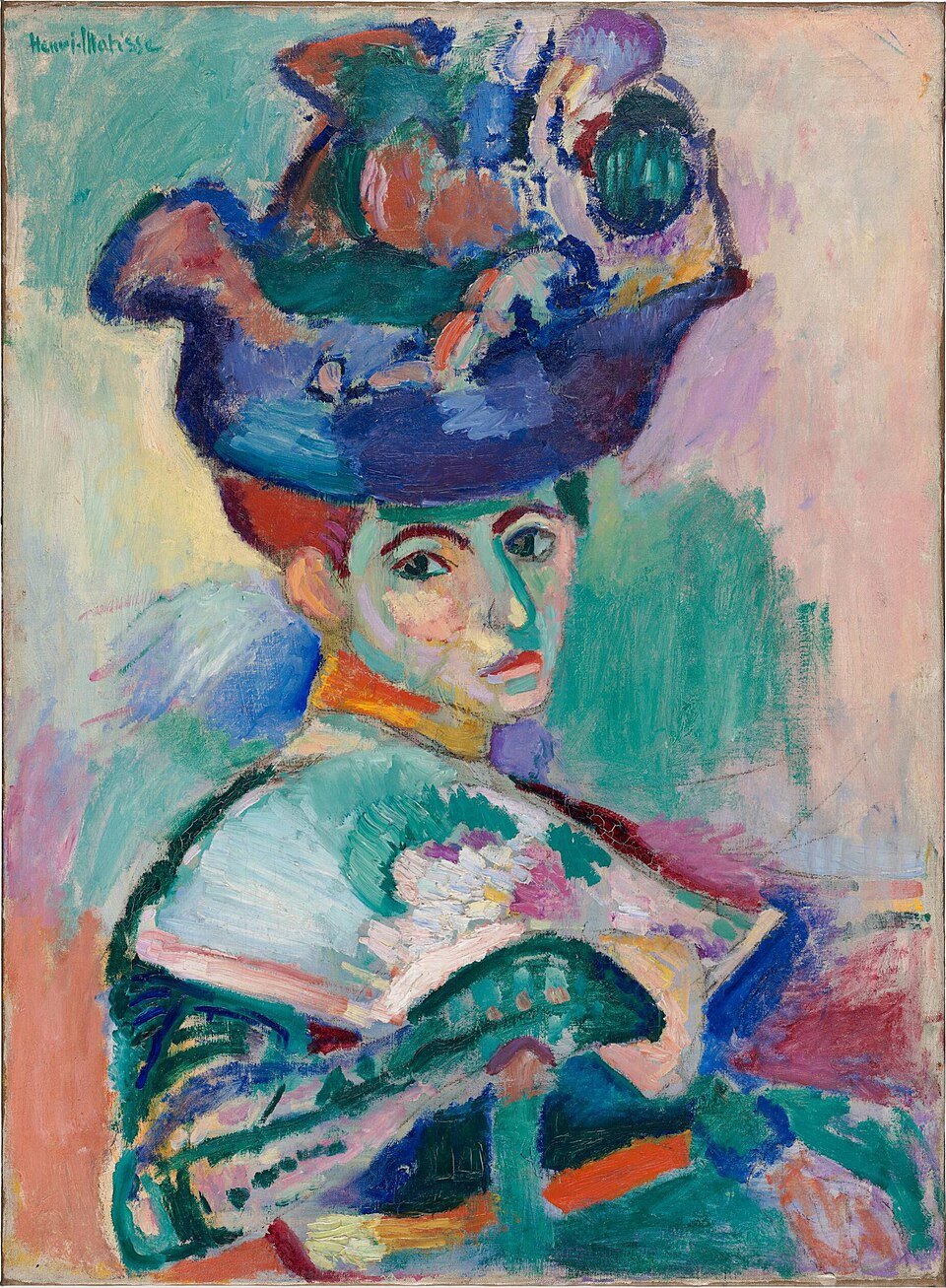
Description: This portrait of Matisse’s wife, Amélie, caused a huge scandal when it was first shown. Why? Because it’s a riot of ‘unnatural’ colors! Her face is a patchwork of green, yellow, and pink, and her elaborate hat is an explosion of bright hues. Matisse wasn’t trying to paint his wife exactly as she looked; he was painting the feelings she inspired in him, using color as his language. The writer Gertrude Stein and her brother bought the painting, with Gertrude later saying she was shocked by the public’s hostile reaction to it.
Painting Techniques: A quintessential Fauvist work, this painting features jarring, non-representational colors applied with aggressive, visible brushstrokes. The colors are chosen for their emotional power, not for their realism.
Location: San Francisco Museum of Modern Art (SFMOMA), San Francisco, USA
Estimated Value: Priceless
The Joy of Life (Le bonheur de vivre) (1906)
Description: This painting is like a dream of a perfect world. It depicts a beautiful landscape filled with nude figures dancing, playing music, and relaxing. The colors are magical—yellow skies, pink trees, and blue ground. It’s not a real place, but an imaginary paradise where everything is harmonious and joyful. The flowing lines and bright colors create a feeling of peace and celebration. The young Pablo Picasso was so challenged and inspired by this painting that it partly motivated him to create his own groundbreaking work, ‘Les Demoiselles d’Avignon’.
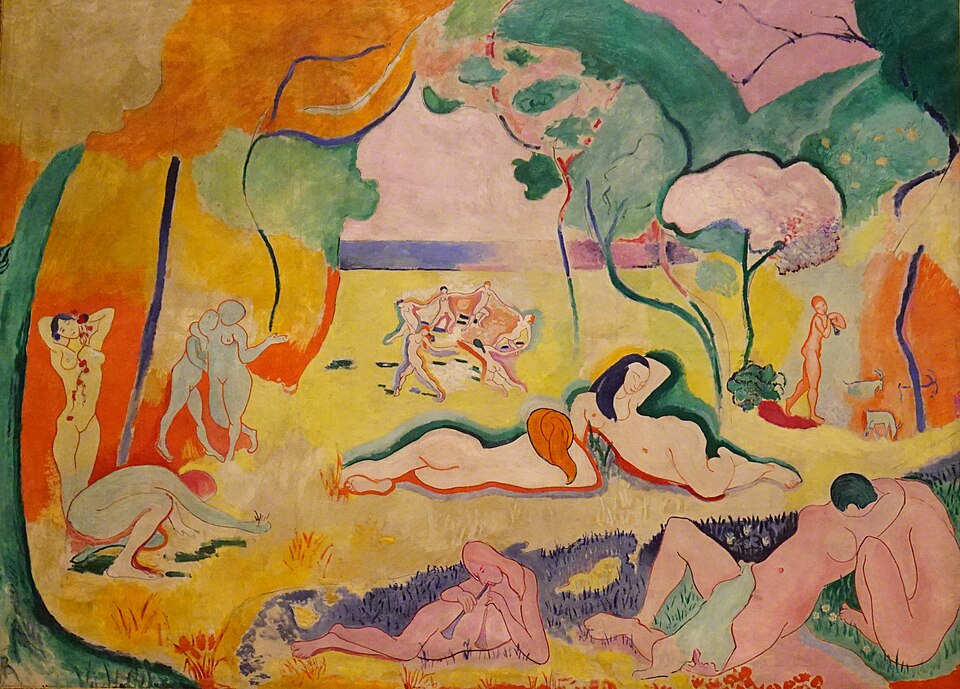
Painting Techniques: Matisse combined a pastoral, classical theme with his radical Fauvist color palette. He used sweeping, arabesque lines to guide the viewer’s eye through the composition, creating a sense of rhythmic harmony.
Location: The Barnes Foundation, Philadelphia, USA
Estimated Value: Priceless
The Green Stripe (Portrait of Madame Matisse) (1905)
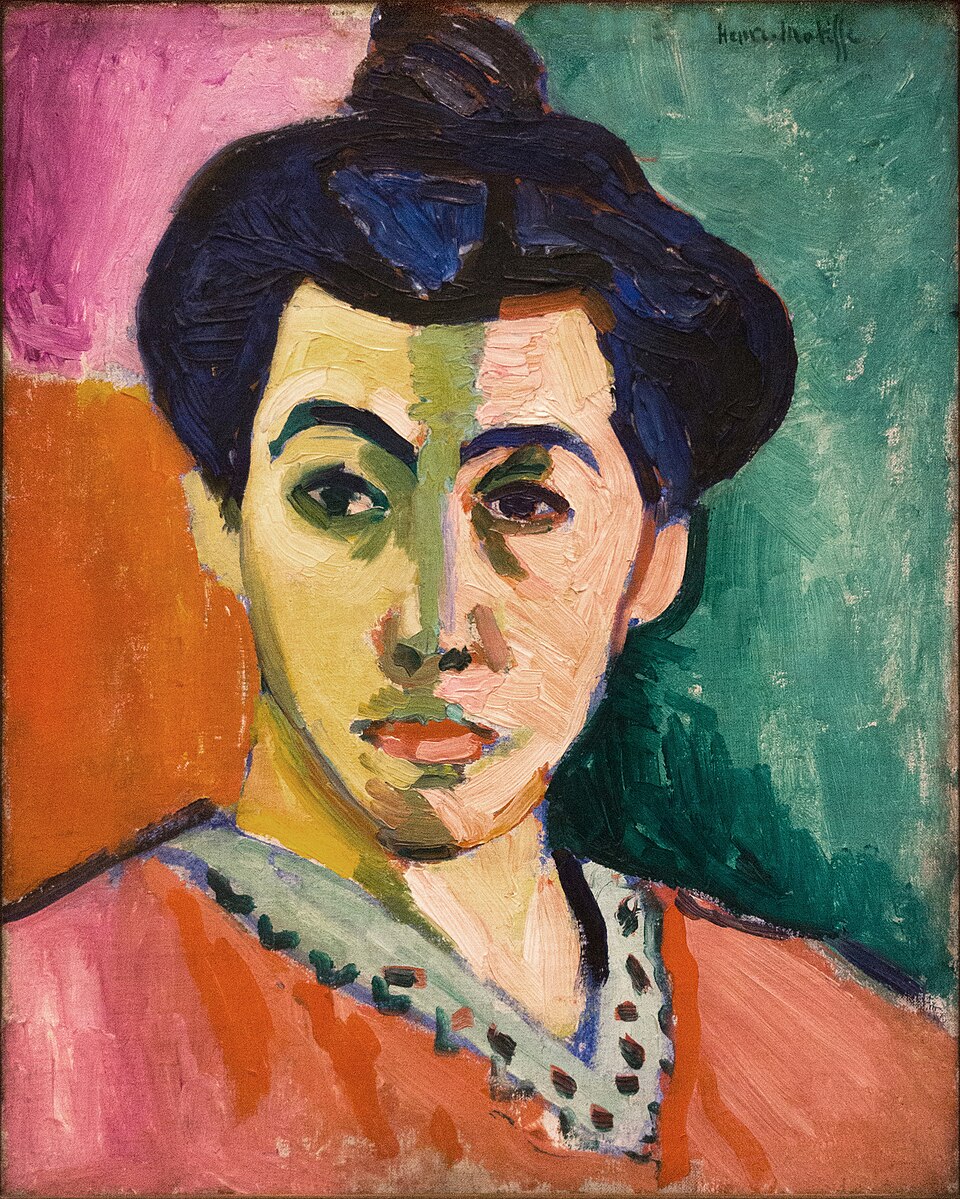
A bold and unconventional portrait, ‘The Green Stripe’ by Henri Matisse showcases his revolutionary use of color.
Description: Another portrait of his wife, Amélie, this painting is famous for the bold green stripe running down the middle of her face. This wasn’t because she had a green line on her face, of course! Matisse used it to create shadow and form, dividing the face into a ‘cool’ side and a ‘warm’ side. It’s a powerful statement that color can be used for structure and emotion, not just for copying reality. The painting’s official title is ‘Portrait of Madame Matisse,’ but it quickly became known by its more descriptive nickname, ‘The Green Stripe’.
Painting Techniques: Matisse used blocks of complementary colors—like red and green, and purple and yellow—placed side-by-side to create a vibrant, clashing effect. The brushwork is rough and expressive, adding to the portrait’s intensity.
Location: Statens Museum for Kunst (SMK), Copenhagen, Denmark
Estimated Value: Priceless
The Dessert: Harmony in Red (The Red Room) (1908)
Description: Imagine a room so intensely red that the tablecloth and the wall seem to merge into one. A woman arranges fruit on the table, and through a window, we see a simple green landscape. The painting plays with our sense of space; is the window really a window, or is it a painting on the wall? The bold patterns and overwhelming color create a decorative, dream-like atmosphere. Matisse originally painted the room blue, then green, before finally settling on the powerful red that makes the artwork so famous today.
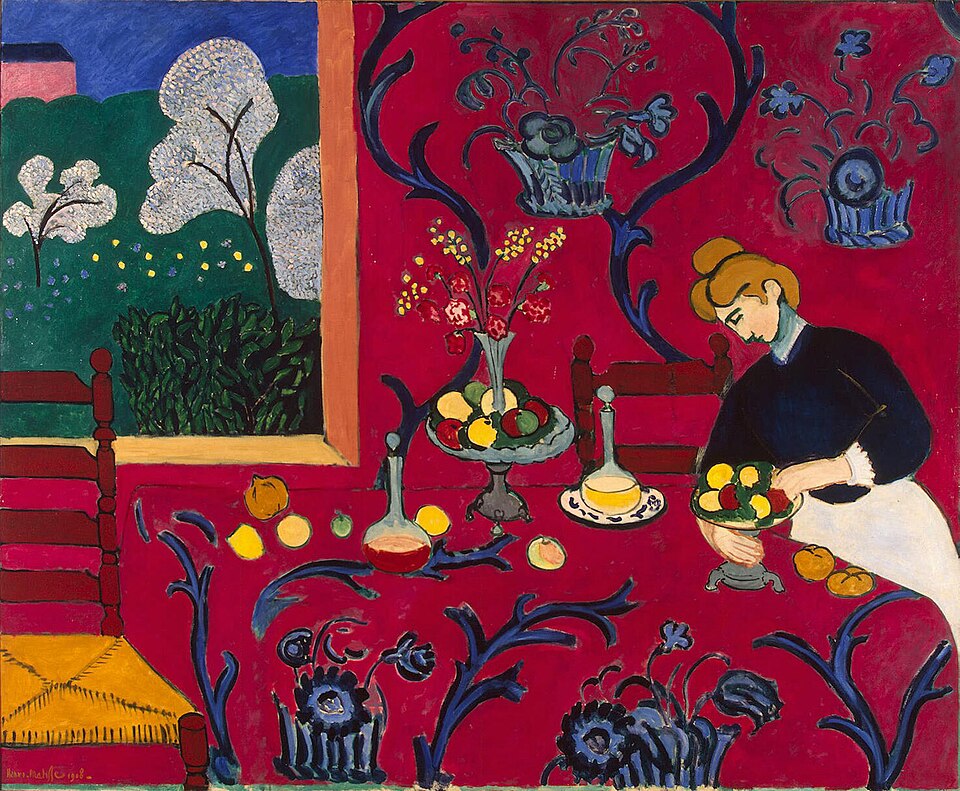
Painting Techniques: This work demonstrates Matisse’s move toward a more decorative style. He flattened the space and used a single, dominant color and a repeating arabesque pattern (the blue vines) to unify the composition.
Location: The Hermitage Museum, St. Petersburg, Russia
Estimated Value: Priceless
Blue Nude II (1952)
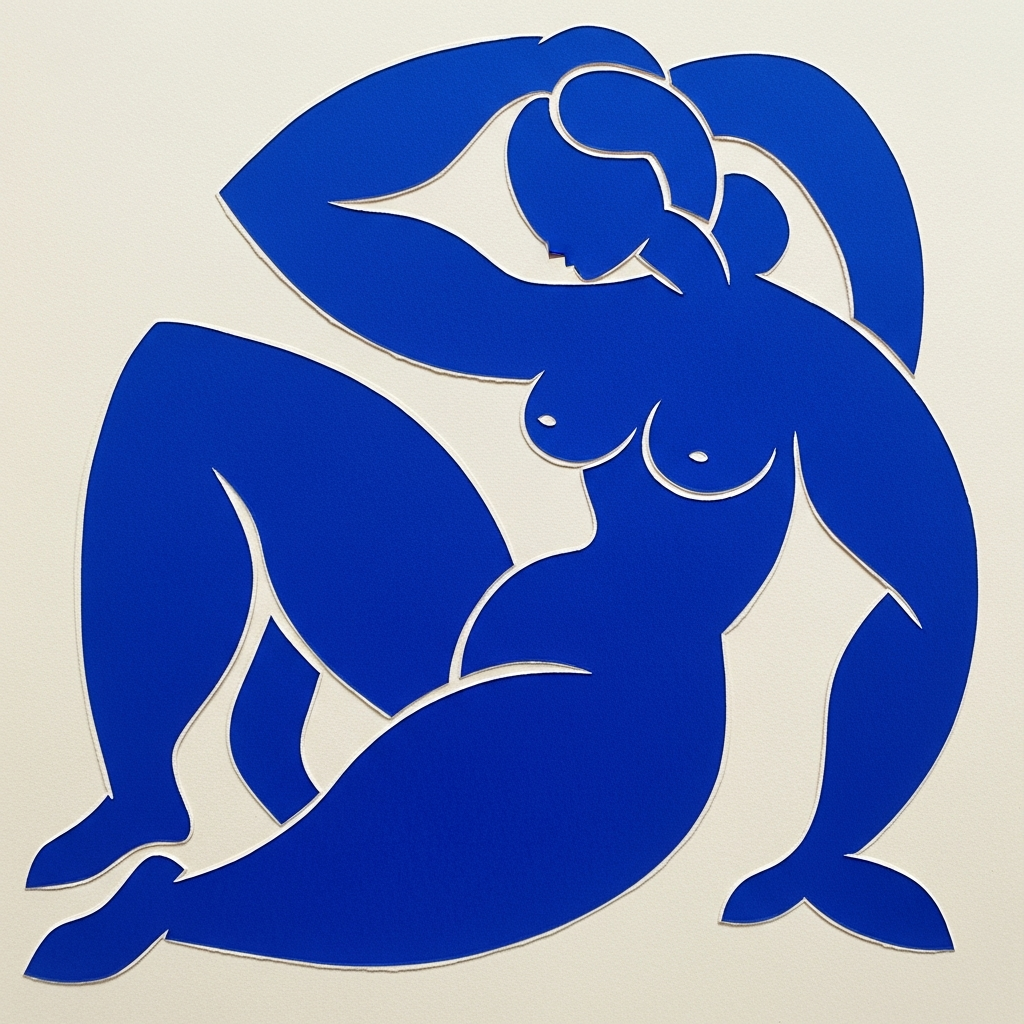
Simplicity and genius in form: ‘Blue Nude II’, a famous paper cut-out by Henri Matisse.
Description: Later in his life, when he was too ill to stand and paint, Matisse started a new art form he called ‘painting with scissors’. He would cut shapes from paper painted with gouache and arrange them into compositions. ‘Blue Nude II’ is one of the most famous examples. It’s a simple, elegant shape of a seated woman, but the bold blue and graceful curves make it incredibly powerful. There are four ‘Blue Nudes’ in this series, and Matisse described the process of creating them as cutting directly into color.
Painting Techniques: This is a ‘cut-out’ (découpage) made from gouache-painted paper. Matisse focused on the absolute essentials of form and color, stripping away all detail to capture the pure essence of the figure.
Location: Centre Pompidou, Paris, France
Estimated Value: Priceless
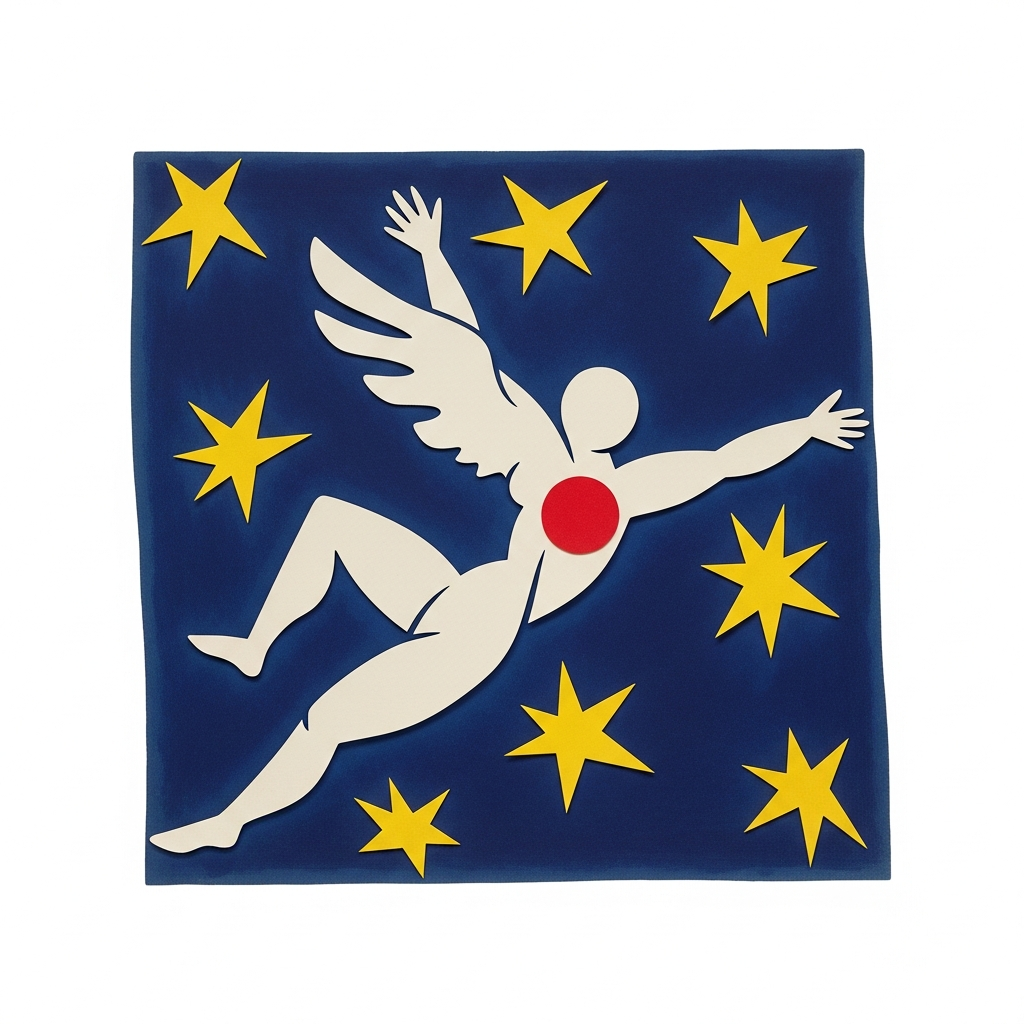
Icarus (from Jazz) (1947)
Description: This image comes from Matisse’s famous artist book, ‘Jazz’. It shows the silhouette of Icarus, a figure from Greek mythology, falling against a deep blue, star-filled sky. The red dot near his heart represents his wound or perhaps his passionate spirit. Even though the story is tragic, Matisse’s version feels almost like a joyful dance, a celebration of striving and daring, even if you fail. Matisse compared the vibrant colors and improvisational feel of his cut-outs to the rhythms and energy of jazz music, which is why he named the book ‘Jazz’.
Painting Techniques: This is a stencil print based on one of Matisse’s paper cut-outs. The technique allowed for flat, uniform areas of brilliant color, reflecting the simplicity and directness of the original cut-paper designs.
Location: Prints are in various collections, including MoMA, New York
Estimated Value: A single print can sell for over $50,000; a complete first-edition ‘Jazz’ book is worth over $500,000.
The Open Window, Collioure (1905)
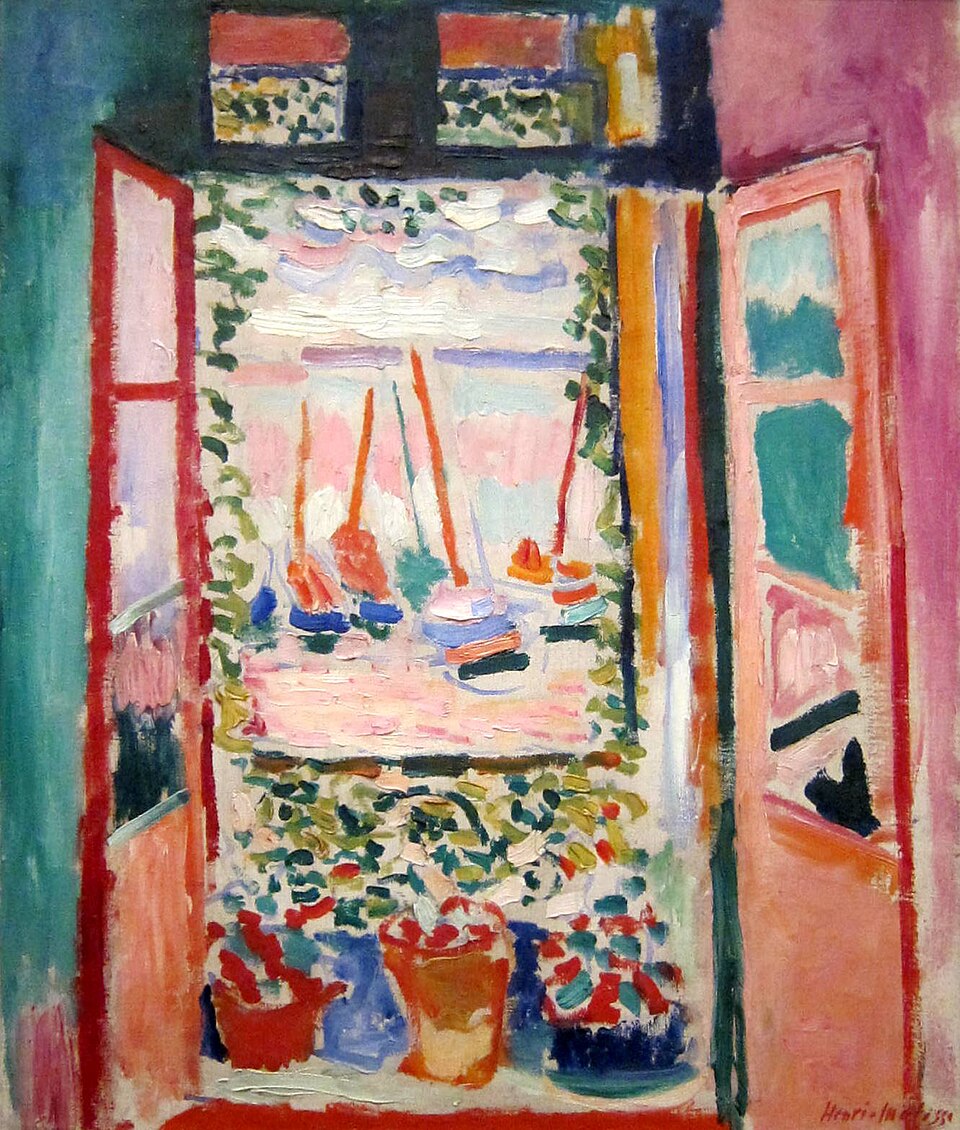
A vibrant view through ‘The Open Window, Collioure’ by Henri Matisse.
Description: Imagine throwing open a window on a sunny day in the south of France. That’s the feeling this painting gives you. We’re looking out from a dark room onto a bright, colorful harbor filled with boats. The view is a beautiful chaos of pinks, blues, and greens. Matisse painted the wall inside the room with clashing colors, making the view outside seem even more brilliant and alive. This painting was exhibited at the scandalous 1905 Salon d’Automne, the very exhibition where a critic mockingly nicknamed Matisse and his friends ‘Les Fauves’ (The Wild Beasts).
Painting Techniques: A key work of the Fauvist movement, this painting uses vibrant, non-naturalistic colors and energetic brushstrokes to convey the emotional sensation of looking out at a sun-drenched scene, rather than a literal depiction of it.
Location: National Gallery of Art, Washington, D.C., USA
Estimated Value: Priceless
Luxe, Calme et Volupté (1904)
Description: The title translates to ‘Luxury, Calm, and Pleasure,’ and the painting is exactly that—a peaceful, sunny scene of women relaxing on a beach. But look closely at how it’s painted. Instead of smooth brushstrokes, Matisse used little dabs of pure color, almost like mosaic tiles. This creates a shimmering, dreamlike effect, where all the colors vibrate next to each other. The title comes from a line in Charles Baudelaire’s poem ‘L’Invitation au Voyage,’ which describes a dreamland of beauty and order.
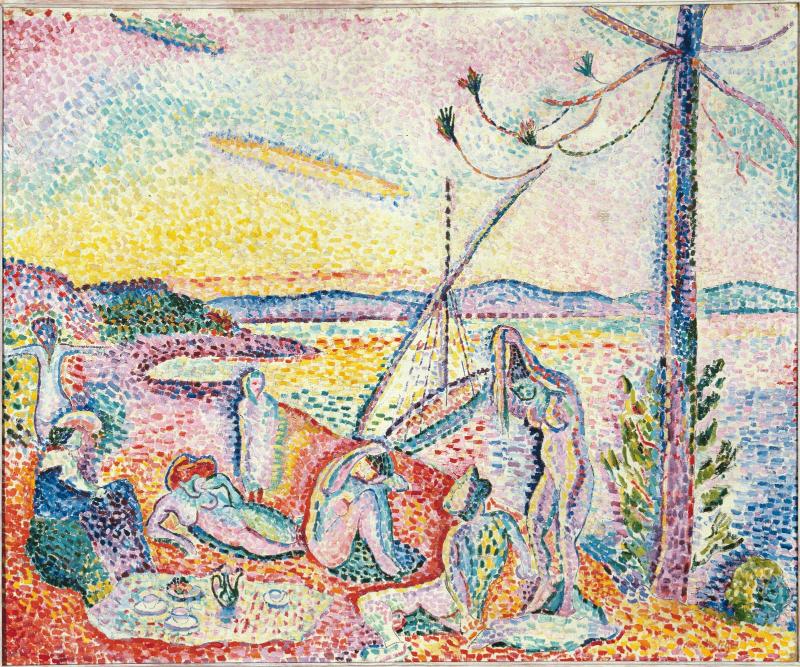
Painting Techniques: This work shows Matisse experimenting with Pointillism (also called Divisionism), a technique developed by Georges Seurat. He used small, distinct dots or dashes of color that blend in the viewer’s eye, but with a Fauvist’s love for brighter, more emotional color choices.
Location: Musée d’Orsay, Paris, France
Estimated Value: Priceless
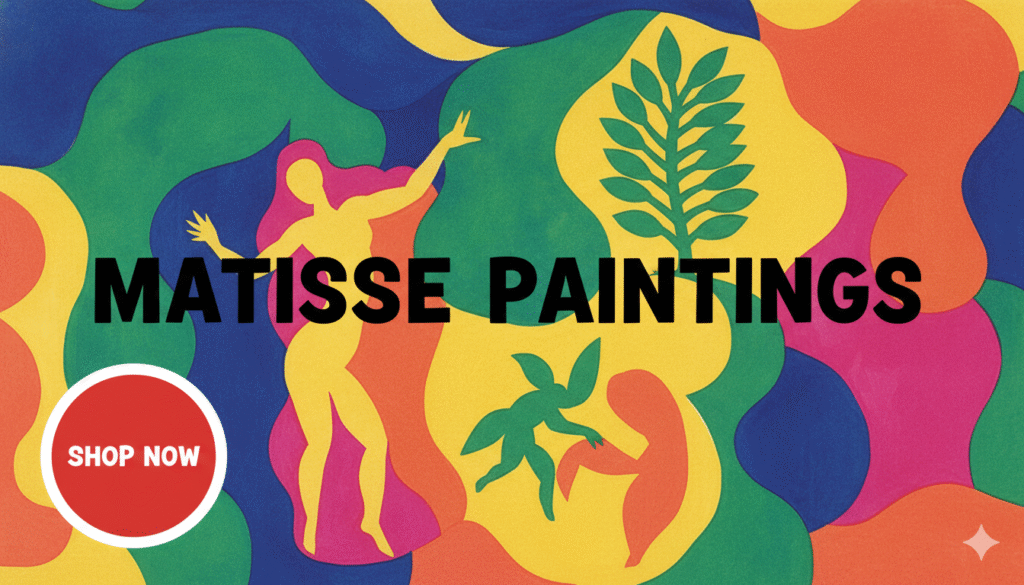
Inspiration and Legacy
Henri Matisse didn’t just invent his style out of thin air. He stood on the shoulders of giants, drawing huge inspiration from Post-Impressionist painters like Paul Cézanne, who taught him about structure and form, as well as Vincent van Gogh and Paul Gauguin, from whom he learned about the emotional power of color. He also admired art from other cultures, including African sculpture and Islamic textiles, which influenced his use of bold patterns and simplified forms. In turn, Matisse’s legacy is immense. His radical use of color and form directly inspired countless artists. The Abstract Expressionists in America, like Mark Rothko and Richard Diebenkorn, were deeply influenced by his large fields of expressive color. His genius continues to inspire artists, designers, and anyone who loves the pure joy that color can bring to the world.
Final Thoughts on Top 10 Matisse Paintings
Henri Matisse was more than just a painter; he was a magician of color. He wanted his art to be like ‘a good armchair in which to rest from physical fatigue,’ a source of calm, joy, and balance. From his wild Fauvist beginnings to his simple yet profound paper cut-outs, his career was a lifelong quest to express his feelings through the purest forms and the most brilliant colors. The Henri Matisse art style remains a powerful testament to the idea that art doesn’t have to copy the world—it can create a new one, full of harmony, rhythm, and light. His work reminds us to see the world not just as it is, but as it could be: brighter, bolder, and more beautiful.
FAQs about Matisse
What is Fauvism and why was Henri Matisse important to it?
Fauvism was a short-lived but super influential art movement in the early 1900s. The name means ‘wild beasts’ because the artists used intense, wild colors that didn’t necessarily match reality. Matisse was the leader of the group, and his paintings like ‘Woman with a Hat’ are perfect examples of the style.
Why did Matisse start making paper cut-outs?
Later in his life, Matisse suffered from health problems that confined him to a wheelchair, making it difficult to paint. Ever the innovator, he didn’t stop creating. He began cutting shapes from paper painted with bright colors and arranging them into compositions, a technique he called ‘drawing with scissors.’ It became a whole new medium for him.
Were Matisse and Picasso friends or rivals?
Both! They were friends but also great rivals. They respected each other immensely and often pushed each other to be more creative. Picasso once said, ‘All things considered, there is only Matisse.’ They are considered the two most important figures in opening up the world of modern art.
Where can I see the most Matisse paintings?
While his works are in museums all over the world, some of the best collections are at the Museum of Modern Art (MoMA) in New York, The Hermitage Museum in St. Petersburg, Russia, and the Centre Pompidou in Paris. There are also two museums in France dedicated specifically to his work: the Musée Matisse in Nice and another in his birthplace, Le Cateau-Cambrésis.


